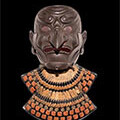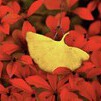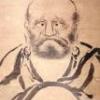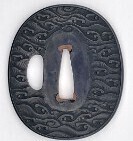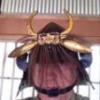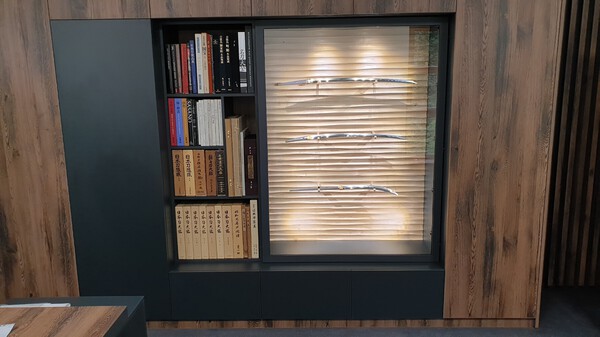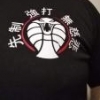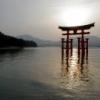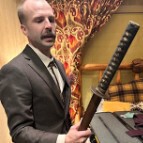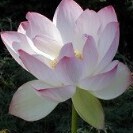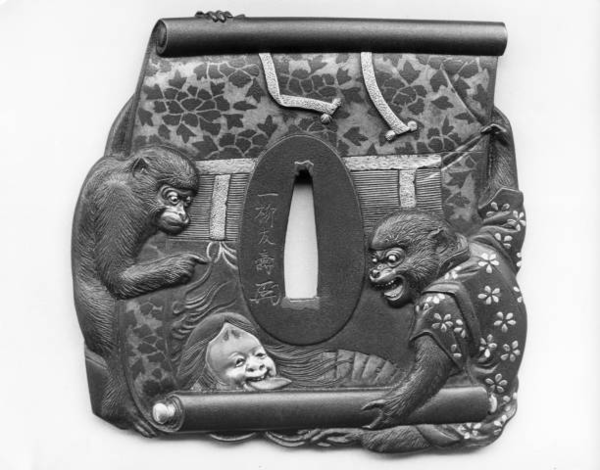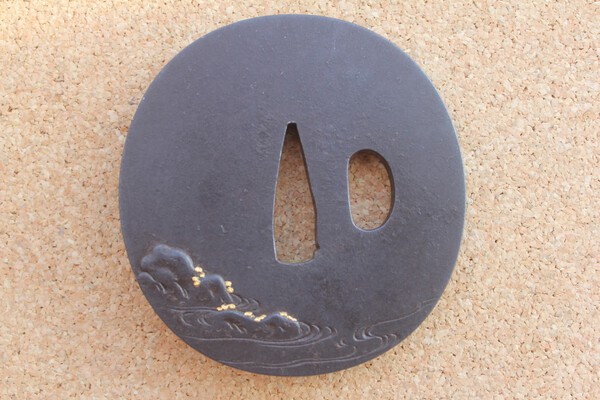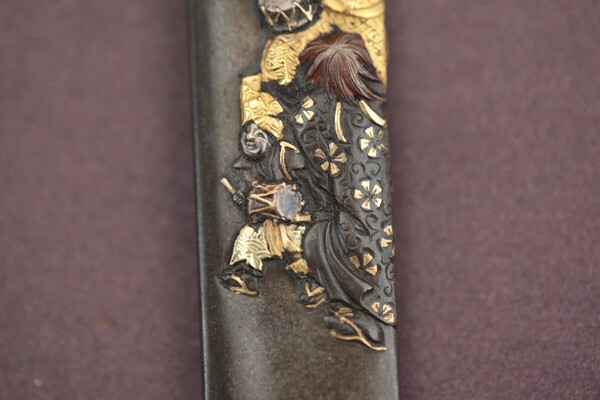Leaderboard
Popular Content
Showing content with the highest reputation on 01/22/2025 in all areas
-
Robert, I think you are mixing up teaching and learning. In a craft, a master can only demonstrate, as experience can not be transferred. Your body has to learn precise movements and skills by repetition. The same applies to sports like archery or golf. In the West, explaining context and correlation may to a small extent shorten the apprentice time, but that is not the case in Asia where repeated action (1.000 times....) is seen as the basis of learning, and this helps avoiding mistakes and flaws. It is not only tradition what makes learning a craft like TOGI very special, it is mainly the experience. Learning in Japan with a master will allow you to see a pattern in the work of swordsmiths. You cannot easily compare 100 blades of the same school or tradition outside of Japan to learn to see what features they have in common. But this is important to avoid mistakes in the restoration treatment. Japanese swords are not endlessly available, and they cannot be polished without a loss of material. So our main objective in preserving them must be absolute competence in dealing with them. I do not think that can be done with shortcuts. P.S. I am teaching forging blades the traditional way, and I know what I am talking about4 points
-
Thomas, Uwe, (and others) everything you say is perfectly true and civilised but, when challenged, instead of engaging in constructive debate, Jacques simple either ignores perfectly valid points and questions, or he diverts away with his “Earth is flat” quote or he resorts to insults. In some cases ( as with me…and others) he resorts to aggressive and insulting unwarranted personal messages which I’m sure he would never dare do face to face. On one post he even called me a liar and when challenged he simply went quiet and refused to explain himself. It’s a shame, rather spoils the ambience of this excellent forum.4 points
-
Uwe, just forget it! I have also offered a discussion here because I partly disagree. I have also already pointed out here that the way Jacques recommends holding a blade should not be used at a meeting and an official Kantei. No reactions whatsoever. Jacques holds the Nagayama in front of him like the 10 commandments and does not accept any comments or respond to them. I do not mean to diminish the importance of the Nagayama in any way. Who am I to do that? It is extremely difficult to write basic books without overwhelming the interested beginner, but at the same time not giving the advanced student too general information. It is always a great balancing act. Anyone who has already written lectures on the subject and has drawn on extensive sources and literature knows that they have to think carefully about their words in front of a qualified audience. That is why you have to research carefully. It is not uncommon to come across contradictions, and sometimes even incorrect statements in sources. Incorrect, in part, because such information is now considered outdated. This is quite normal, and that is why preparing such presentations is a lengthy process. Formulating your own theses from your own research paper - if you identify them as such - is certainly fruitful. "For this or that reason, I am of the opinion that..." has a completely different potential than "that's the way it is because it says so, basta!" It is often recommended, especially for beginners, to invest in books first. The correct thing would be to invest in books in parallel to a practice of studying blades, guided by an experienced person. More than 30 years ago, I also bought every book I could get (back then there was no internet). The result was that I thought that my run-of-the-mill blades looked like the Kotetsu or the Chogi in the photos in the books (on which you could basically hardly see anything). It was only when I was invited to a meeting of the NBTHK-EB many, many years ago that I realized that I had to completely change my opinion. I was just beginning to see and understand. There is no substitute for practice! But there always has to be someone experienced who explains to you what you see and what you have to pay attention to. It is very important that you say what you see yourself. But also what you are not able to recognize at the moment. Only then can the teacher intervene and help. I know that unfortunately not everyone has the opportunity to do this. At the same time, however, I also want to smooth things over. This thread is not about anything fundamentally wrong, but rather about nuances - about points of view - which basically have little impact on the overall result. I also don't want to start a war of terminology. That's not worth it here. Everyone - or at least some (I think that's a better description) will notice that with increasing experience you become more relaxed and flexible, rather than more cemented and rigid. The reason is simple, nothing is set in stone. There is nothing that doesn't exist. You always learn something new, which can also change your own opinion. You always know people with whom you can exchange ideas well, and people with whom you're better off not talking.4 points
-
How will you address the issue of learning kantei so you can then properly know what the blade was supposed to look like when created by the school or smith; selecting the right stones (there is a reason they have MANY stones, and not just different grit) to bring out the details of the blade so it (as closely as possible) highlights the characteristics of individual time periods, schools, smiths, etc.; selecting the right final polishing stage(s) that allow for the best viewing of the characteristics of specific time periods, schools, smiths, etc.; learn to correct many common flaws; learn to polish to avoid making certain flaws MUCH worse; etc., etc., etc.? I guess I will ask the obvious question… why do you believe there is a 10 year apprenticeship, and why do you believe those that promote that apprenticeship as necessary do so?4 points
-
4 points
-
3 points
-
In theory, practice and theory should be the same, but in practice, they are not.3 points
-
Dear Thomas, all that you write is right. But you have to contradict Jacques because here are less experienced people. You have to say what ist right and what is wrong. Imagine you go to the Sword Museum and you hold a sword as Jacques says. There is a deep river right in front of the Museum. No one will ever find you...3 points
-
Of course o-midare and ko midare are not the same thing. But the question is: hamon or characteristic? Nagayama says both are hamon; you say it is just a characteristic. Whom would you trust: an author or the selfclaimed greatest expert for Japanese swords outside Japan? That must be you, because you are always right and no one else. And what do you do, when the hatarakis are the hamon just like here in the case of Norishige. Or when the hamon is full of hatarakis like in any top-level Soshu blade? Ignore it? Yukimitsu, Masamune, Norishige, Kunimitsu, Hiromitsu. Don´t you see, that you write things that are wrong right from the start? I know your problem. But you will never solve it because you can´t cross the invisible border.3 points
-
As I promised in last kantei thread I was looking to make another one. I was happy with the participation in the first one, so I thought it would be fun to make a second one. Unfortunately again I have to use pictures from various books for this sword as I cannot provide real life kantei example. This should to my understanding be somewhat typical work of the smith, as that is important when trying to identify the smith. As this is just fun guessing to get people involved it would be wrong to choose atypical example by the smith. Just for the fun of debates that we had recently I typed in sugata, kitae and hamon descriptions in Japanese from book where this item is featured. I tried to translate them to English but there are the Japanese original texts as I might have made errors. I hope everyone will have fun in this one too. This time the pictures should be bit better than last time as I could choose best ones from multiple books. I will post the answer on 31.1. so everyone should have time to look and participate if they want. Nagasa: 73,9 cm Sori: 2,1 cm Motohaba: 3,2 cm Sakihaba: 2,2 cm Motogasane: 6,2 mm Sakigasane: 4,0 mm Kissaki: 3,3 cm Nakago: 20,4 cm Shinogi-zukuri, iori-mune Width is normal and sugata is good with slight koshi-zori. 身幅切先とも尋常やや腰反りのついた踏張りのあるよい姿である Well forged ko-itame hada, with thick ji-nie. 鍛え小板目よく約み, 地沸厚くつく Hamon is ko-nie chōji-midare mixed with gunome, there are tobiyaki 刃文小沸深い丁子乱に互の目交じり, 処々飛焼きごころある Nakago is ubu, 1 ana with ha-agari kurijiri. On omote side there is a 7-character signature and there is a date on ura side.2 points
-
2 points
-
2 points
-
Dear Colin, Jacques is more or less insignificant. But I can´t let is stand undisputed. I write for all the others here just to show that there are other sources and other opinions. And when you are silent things get worse. So, better to write and show some pics than stay silent and let Jacques come up with something that is totally wrong. I can only hope that none of the Japanese experts read here. "Died while laughing" would be in the death certificate. And Jacques would the reason.2 points
-
Well, on the latter point, I definitely wrote that I don't recommend it at official meetings. I have already made a few oshigata, holding a blade in every conceivable position to the light in order to be able to see the characteristics of the hamon exactly. In fact, it is absolutely necessary. But I can't do that at a meeting. Besides, I can still see best with the traditional way. But I can certainly understand Jacque's basic idea (reading from the cutting edge to the shinogi). Maybe you can do it that way for yourself. At home, of course. I'm more of a calligraphy person. I read the blade the way the Japanese wrote it, from top to bottom (okay, sometimes upside down ;-)) For me, the boshi is the head, the face of the sword, the main theme of the hamon is the body, the yakidashi region is the foundation, the base. I do it this way because I can put the sugata in proportion at the same time. For example: is the shape right? Am I unsure about this, do I see something yakidashi-like? No? Does the blade have fumbari? No? So possibly O-Suriage... And no, a yakidashi is not something that is necessarily only found from the Momoyama onwards. Of course, in Shinto, the yakidashi is sometimes strongly defined. But a hamon always arises somehow in the Ha-Machi region. Sometimes with a bang (Koshiba), sometimes with a delay (Yakiotoshi). The same applies to the boshi, especially the character of the kaeri. If you see such information in combination with the sugata, I have usually already decided on a certain direction during the kantei. That's why I, at least, read a blade from top to bottom, like a scroll. At least that is my view, I have tried to explain it and am open to objections from which I can learn. I think that's how a good discussion works.2 points
-
2 points
-
2 points
-
2 points
-
2 points
-
Hamish my pricing is always competitive considering I do several trips to Japan each year to hand pick each one of my swords, take care of the importation and related expenses. Then fly to each capital city in Australia to show clients many swords they can personally view and handle, which they may not have the opportunity otherwise. Anyway, I won’t make further comments on Nick’s post. I'm sure I'll catch up with Nick for a beer 🍺 in Melbourne or Japan.😁2 points
-
2 points
-
We have recently acquired a large collection of Japanese swords from a private collection. We will be listing on our website in coming months. Also we will be doing exhibitions in most capital cities throughout Australia if you are a collector and have an interest in purchasing high quality certified swords please contact me. If you are visiting Cairns don't forget to come and visit Samurai Gallery Australia the only Japanese Samurai museum in Australia Kind Regards John Grasso 04176429212 points
-
2 points
-
2 points
-
Dear Jacques, I am sitting in my armchair, drinking a whisky (Laphroaig, 10 years, cask strength) and i read your posts. Either you just want to provoke contradiction for your self esteem or you are clueless. But I doubt the clueless label. Nummer 1: hold the blade horizontal with the edge down to study the hamon. I have never heard, read or seen something like that. Maybe you can do that at home. Alone in your attic. But at a meeting? Handle & care? Etiquette? Ever heard about it. Please show me a description where it is allowed to hold a sword as you recommend. Number 2: midare is not a hamon but a characteristic. Well, Kokan Nagayama page 96 says something different. And page 105 and 106 give examples for midare hamon and schools to the different kinds of midare. By the way: what is sanbonsugi? A hamon, a characteristic, both, none of them? And now number 3: only the hamon drawing is required, the hataraki can be ignored. Good luck! With greetings from the armchair Uwe G.2 points
-
2 points
-
2 points
-
2 points
-
Dear sword enthousiasts. In this post you'l find a link to the up and coming Japan Art Fair in Utrecht, The Netherlands. I will be there :-) JAF – Japan Art Fair1 point
-
If you are talking about the 2 items above, there is no such thing as menuki for it. It's not a tanto. The blades/kogatana are a loose fit, and are usually "glued" in with pine pitch etc. But it's normal to have a loose fit, it is only in there by friction.1 point
-
1 point
-
Dear Stefano. To answer what might be part of your question, the smith who made the kogtana, the blade, is almost always a different person to the one who made the kodzuka. Different crafts - different makers. Both kodzuka and kogatana are often swapped and or replaced, for example I have a wakizashi which came without either and I have added them since. It would be impossible to say when this was done or to get the period of the koshirae as a result, after all it is quite common to find a sword mounted with a much earlier tsuba or a late koshirae made with earlier pieces. If your question in bold is what I think then there are styles of mounting without menuki. If the silk ito looks original then you might see some slack if menuki have been lost or the remains of some adhesive if they were fixed outside the wrap. A photograph of the tsuka would help us. All the best1 point
-
Having participated to this thread, I want to greatly thanks Michaël, Thomas and Uwe for their posts with nuances and corrections. Please, don't stop precising things that you think they have to be precised. I'm agree with you, Uwe, with the fact that us, newbies, always need the counterpart to forge a opinion. Paradox is that Jacques is frequently sustained by experimented folks here, saying he is frequently right... but being constantly countered... making the whole thing not always understandable for us, common people. Moreover his attitude don't simplify that. Jacques, you are challenged with strong arguments, you have to answer more constructively. As I said to you, I tried to past through your attitude to see what you really have to say, I played the game. Here I'm struck to see how your knowledge is constructed with strong bias. Isn't there a bit of cognitive dissonance you tend to resolve by misinterpreting reality rather than nuance or change your opinion? That's sad because you obviously have worked a lot. You would gain taking a step back and think about it. Best regards to all1 point
-
1 point
-
Hi Stefano, On the kozuka: 吉岡因幡介 - Yoshioka Inaba (no) Suke On the kogatana: 河内守国助 - Kawachi (no) kami Kunisuke1 point
-
Dear Jacques, I don`t know if that even counts as an intellectual argument. But let´s be generous: No! Because this is how a discussion works. You come up with arguments. Based on facts or not. So, all you need to do is: Prove me wrong! And if you don´t or can´t then I must be right. I´m waiting in my office, different armchair and no whisky. So, display your arguments. The stage is yours.1 point
-
Hello! Thank you everyone for the kind words. I think it was a joke, but I'd like to take this oppurtunity to say that I consider John a good friend! and I look forward to working along side him in this field and hope that we can support each other! 👍👍 We don't have a physical store yet, but a viewing can be arranged, both in Japan and Australia. Prices are in Yen because the main business is in Japan and payments are typically to be made to the company account based in Japan, but we keep some of the inventory here in Australia and some in Japan. I look forward to working with you all!1 point
-
Tsuba = Guard Seppa = "Washers" that go on both sides of the tsuba. Tsuka = Grip / handle. Fuchi =the cap at the end of the handle where it meets the Tsuba(guard) Kabutogane = Metal fitting at butt of the grip. Called a kashira on katana fittings, and on my source below. And if you have any further questions, below is my source: Hope this helps! Cheers, -Sam https://nihonto.com/about-swords/diagrams-terminology/#:~:text=Fuchi – The cap at the,secure the scabbard when drawn.1 point
-
1 point
-
Thanks for the information. It will be passed down to my son in due course as is—a fourth generation family heirloom.1 point
-
Well Kung Foey, I am yodan level. If someone came to the dojo and stated what you said I would just have them sit and watch a class. Then after class I would explain the particular martial art that is taught and if they are still interested I would give them a coupple of free lessons. I have done that before (with sensei’s permission). Of course I have always been interested in Japanese art. And I have even practiced iaido. But real swords are expensive, that is why I am asking about tsuba and stayed with stamp and coins. My friend, who is also a martial artist collects some tsuba and got me interested and emailled me about the forum. Although they also can be expensive, I have seen some that are not expensive. So I think I will learn more about them, as others on the forum have stated some good information how to learn and then try my first purchase. I will wait for my friend to send me the beginner book, and I have also ordered some other books. In the meantime I will just keep training in martial arts and learn about tsuba collecting.1 point
-
Although I cannot recall specific details now, I did run into a very similar sword with virtually the same style mountings some 30 years ago. Only both the mountings and sword were of better overall quality, and the sword had an elaborate lengthy script writing on the nakago. When presenting an oshigata of the nakago and verbally describing the piece to an advanced collector in the club, his thoughts were that this sword was most likely a (pre-war?) presentation piece for some occasion with an honorary mei. The sword itself he didn't believe would be of serious collector quality. The subject sword here, I believe based on the images, would follow along something of those lines. Try looking up; Japanese Phoenix. p.s. due to exceptions, Japanese swords should be evaluated based upon their own merits.1 point
-
Definitely a real Japanese sword, hand forged and antique. Adding spurious signatures is a tradition going back many hundreds of years, it is very very common. There are various reasons, you can read about them in the FAQ above the forum.1 point
-
1 point
-
1 point
-
Awesome examples, Dale! Thank you for all these. It's also good to know some of the common fakes. I particularly like this one that I've quoted from you above! Coincidentally I have a vintage frog themed collection. Just little things i've picked up over the years shopping antique stores. Some frog tosogu would really be the cherry on top! Cheers, -Sam1 point
-
Don't go for these either! https://www.jauce.com/auction/t1128823426 https://www.ebay.com/itm/275533181538 https://www.ebay.com/itm/283780856270 Carter's Price Guide to Antiques and Collectables. This would not strike me as a worthy piece to be included in such a guide! These are nice though! https://www.tessier-...fer-a-decor?search=& https://www.tessier-...-1945-mokko?search=&1 point
-
Lex, I found this online: HOAN TSUBA inherit their name from the founder of the Hoan school, SABUROEMON HOAN, who worked in OWARI province. It is believed that he died in 1614, and is buried at KOKUZANJI Temple. After 1600 the school moved to KII province and became retainers to the ASANO clan. They received a stipend of ten KOKU of rice (which is very little). Haynes lists eleven generations, ranging from early Edo to the beginning of the twentieth century. The second generation was known as HISATSUGU, KANENOBU, and YOEMON. Born in 1600, he was the son in law of the first generation HOAN. In 1619 he went with ASANO NAGAAKIRA (1619–1632) to HIROSHIMA. He succeeded his father as head of the family in 1645. He later worked for a branch of the TAKEDA DAIMYO family. Works signed HOAN KANENOBU are not rare, but they seem younger than the dates given to the second HOAN master The third generation was HISATSUGU, as were the next nine generations. The fourth generation also worked for the ASANO DAIMYO, and received a stipend of 800 KOKU of rice. Starting with the sixth generation, it appears they were no longer making sword fittings, but were ship builders. It seems that the tenth generation did make some fittings in the HOAN style, but were primarily ship builders.1 point
-
1 point
-
Item No. 278 Iron Tsuba with shakudo , gold and copper 7.51 cm x 7.16 cm x 0.54 cm Subject of a European, possibly a Dutchman , with his matchlock gun and hunting dog ( definitely a male ). Signed Toshinaga with kao, early 1700's. A foreign devil caricature of a huntsman wearing his best outfit and generally lording it about with the assistance of his canine companion. Early Nara school piece in good original condition. Ex. Roland Hartman collection Ex. Edward Wrangham collection1 point
-
1 point
This leaderboard is set to Johannesburg/GMT+02:00




